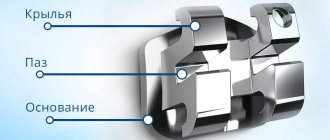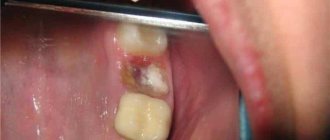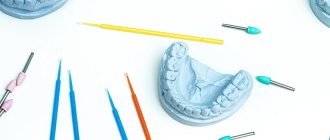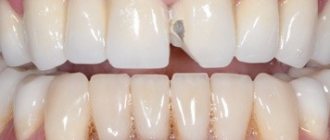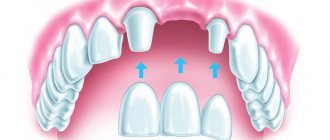Having installed braces in installments , at full price or on a promotional basis, the patient receives recommendations from the attending physician on how to care for them. Orthodontic treatment is accompanied by the need to especially carefully observe the rules of oral hygiene, as well as to stop eating a number of foods. A patient who does not follow these rules may experience braces coming off.
Metal, ceramic and sapphire braces are attached to the teeth using a special glue. Alignment of teeth and reduction of gaps between them is carried out using an orthodontic metal arch passing through braces and secured to the molars. Due to the tension arising in the system, the teeth gradually change their position, lining up in an even row.
| Metal braces When you decide to pay attention to your smile and make it perfect, you will be faced with the question: what method of bite correction should you use? Orthodontics has come a long way in recent years, and many new techniques and devices have appeared. But high-quality metal braces remain one of the most popular types of teeth straightening today. Specialists at the Moscow Smile Studio clinic often recommend metal braces to their patients, and there are explanations for this. | 99 900 ₽ Interest-free installments for 12 months! |
The stability of a tense brace system is highly dependent on increased pressure or sudden physical impact on its elements. If the glue used cannot withstand the additional load, the fixation of one, or less often several elements, may be broken.
Why do they put braces on teeth?
Installation of braces is a common method of orthodontic treatment. These structures help correct malocclusion, straighten teeth and help make your smile beautiful.
In this article
- Why do they put braces on teeth?
- How is a braces system installed?
- The bracket came off: what is the reason?
- What to do if the bracket comes off?
- The bracket has come off - what to do? Option 1
- Option 2
- Is it possible to reinstall a loose bracket?
- How does gluing happen?
- How long can you walk without braces?
- What to do if the last bracket comes off?
- Prevention of braces coming off
- Conclusion
Braces are small plates attached directly to the surface of the tooth, which are combined into a common system with a metal arch with shape memory. The orthodontist first calculates where the bracket should be placed on the tooth so that the displacement occurs in the right direction. And when the arch tries to return to its original shape, it puts pressure on the braces, and they, in turn, affect the teeth.
Problems and inconveniences during dental treatment
After installing the braces system and starting treatment, the patient may experience various inconveniences. We have prepared special material on the most common problems and ways to solve them.
Content:
- 1. Cheek scratching
- 2. Arc problems
- 3. If your teeth hurt
- 4. Food restrictions
- 5. If the bracket falls off
- 6. If the diction has changed
- 7. Problems with intermaxillary elastics
If something rubs or scratches your cheek
Take a mirror and look at your teeth in bright light. Try to find out which part of the system scratches the mucous membrane of the tongue or cheek. During the first 2-3 weeks, the uneven edges of the braces may scratch or rub the mucous membranes of the cheek, lips or tongue. If this causes serious inconvenience to you, take the protective wax that we gave you on the day your braces were installed. But remember that without wax you will quickly get used to orthodontic equipment.
Take a small piece out of the wax box, roll a small ball in your hands and knead it on the protruding hook of the bracket. The bracket itself or the tip of the arch, first blot saliva with a paper napkin. After some time, the wax may fall off, then repeat this procedure again.
Metal ligatures (white metal ligatures). The tails remaining from metal ligatures are bent towards the tooth and usually do not interfere at all. If, within a month of actively brushing your teeth with a brush, the tail of the ligature becomes bent and scratches the oral mucosa, then the patient, independently, but very carefully, can bend the tail of the ligature under the arch with half a wooden toothpick.
Arc problems
The arch is not fixed rigidly in the locks on the last teeth. It fits freely into the locks and can move back and forth without restrictions.
1. If, while eating, the initial super-elastic arch has popped out of the last lock and is in the way, you can insert it back yourself. To do this you need a mirror, good lighting and tweezers (nail clippers). With one hand, pull back the cheek, and with the other, take the tip of the arch with tweezers, very carefully, without bending the arch 90 degrees, insert it into the lock (the lock is a tube into which the arch is inserted).
2. The tip of the arc digs into the gum or cheek. As the teeth are aligned, the arch takes on a more even shape, and the end of the arch may come out of the last locks, injuring the mucous membrane of the cheeks or gums. In this case, if this causes serious discomfort (“I can neither eat nor speak”), you can come up without an appointment and the doctor or his assistants will cut off the problematic tip of the arch (if the tip has protruded by more than 3 mm).
If your teeth hurt
a) After installing braces, in the first 3-4 days you will experience pain only when biting or chewing food. It happens that teeth hurt for up to 10 days (very rarely). Sometimes there may be no pain at all, this is also normal.
b) After activation (control visit), during which the arch was replaced, the tooth/teeth may ache for 1-2 days, but also only while eating. Rarely do any patients resort to using painkillers these days, but if you feel the need for this, take those painkillers (ketanov, Nurofen, Nise, etc.) that you have on hand.
c) During the procedure for removing braces, the patient experiences slight discomfort (but it lasts 1-2 minutes) AND THAT'S ALL!!! THERE WILL BE NO OTHER PAIN SENSATIONS!!!
Food restrictions
To avoid damage to the equipment, you may need to avoid certain products. It is impossible to list all the foods that cannot be eaten, but each patient must determine for himself the force with which he can bite into his favorite food without damaging the braces.
We recommend not to eat: nuts (in any form), crackers, dried fruits, hard confectionery, caramel, toffees, sweets (especially grilled), hard toast, unhulled seeds, popcorn, chips. Raw carrots, radishes, turnips, hard fruits (apples, pears can be cut into slices), fruits containing seeds (peaches, plums, apricots, cherries, it is better to break them, cut them or separate the stone).
In the first months of treatment (in the initial arcs), you should not combine cold and hot foods together (ice cream and coffee, cold yogurt and a hot drink, etc.). Sudden temperature changes can disrupt the properties of the arc (the most important element in the bracket system).
If a brace falls off
Why do braces fall off, reasons?
- 1. When chewing or biting off hard food.
- 2. If you try to pick out something stuck under the archwire or between the braces on your own.
- 3. If the teeth have changed their position and there is contact of any tooth with the brace of the opposite jaw. If you do not notice this and do not tell the doctor about it, then, most likely, the braces will fall off as soon as you eat or when you force your teeth together.
Often in such cases, the patient does not immediately detect this problem. And to his surprise, while brushing his teeth or the next day, he identifies a lock that has fallen off, for a reason unknown to him.
What to do?
If you have external braces:
- — try to quickly make an appointment for an unscheduled appointment;
- - if you wear intermaxillary elastics, then stop wearing the elastics until the bracket is glued.
If you have internal braces:
- — try to quickly make an appointment for an unscheduled appointment;
- - if you wear intermaxillary elastics, then stop wearing the elastics until the bracket is glued;
- - do everything so that the bracket does not get lost;
- - if this is a bracket on the last tooth, and the arch is not bent behind the bracket, then try to very carefully remove it from the arch and save it. If the bracket does not come off, do not apply any force; you may damage the adjacent bracket. Leave it in place, it won't get lost.
If the diction has changed
Diction may change slightly only with lingual (internal) braces. With the new miniature lingual braces INCOGNITO, there is virtually no impairment of diction. But if you still encounter a similar problem, short-term exercises with ditties and tongue twisters will help restore your eloquence:
There is firewood in the yard, the gang is on the firewood, the gang has grass, all the gang are used for firewood. Karl stole dollars from Clara, and Clara stole the quarterly report from Karl. The workers privatized the enterprise, privatized it, but did not privatize it. The beggar rustles in thousands and fifty thousandths. The highest echelons marched towards their sponsored people along the highway, drunk. Regulators regularly adjusted the regulators. It is not clear whether the shares are liquid or not. Taxable grace. The guru's inauguration went off with a bang. The exhibitionist has small biceps. The moron got into the habit of doing bodybuilding. Sasha herself is perfection, and she’s also improving herself! Unpromising. In Kabardino-Balkaria, valocardine is from Bulgaria. De-ideologized, de-ideologized, and pre-ideologized. He who does not work does not eat what he who works eats. Turner Rappoport sawed through the pass, rasp and support. Coconut cookers boil coconut juice in coconut cookers. The eyes of a gazelle were staring at her from behind the spruce tree. Underqualified. Sasha walked along the highway and sucked on a dryer. Senya is carrying hay in the canopy, Senya will sleep in the hay. The cap is not sewn in the Kolpakov style, the bell is not poured in the Kolokolov style, the cap needs to be re-packed, re-capped, re-forged, re-capped. The heron wasted away, the heron was withered, the heron was dead. From under Podvypodvert.
After 3-4 days of training, your diction will become even better than before installing braces.
Problems with intermaxillary elastics
1. Take your time to remove the elastic on the first day of your appointment. Before removing the rubber bands the doctor put on, study which tooth they were put on, so as not to confuse them in the future, because... it makes a big difference. And neither the administrator nor the doctor will help you over the phone.
2. Sometimes elastics break within 24 hours. Because one elastic should be changed 1 or 2 times a day (as prescribed by the doctor), we recommend carrying a bag or small box with a small number of replacement elastic bands.
3. You need to remember and know what animal is drawn on your bag, because... Sometimes the rubber bands in the bags run out, and the patient or his parents can drive up to the clinic, name the animal on their bag to the administrator and receive a new bag of rubber bands. Or tell your doctor about it at your scheduled visit.
It is important not to take breaks in wearing, because... The result achieved in months, you can lose in a week of not wearing elastics. Only a doctor can cancel elastics. Just because your bag is out of rubber bands doesn't mean you don't need to wear them anymore.
4. If the hook falls off, the arc jumps out of the lock, the lock on which the elastic was put on, or any other lock breaks while wearing elastics, then in this case you need to stop wearing elastics and report the problem to the clinic.
During treatment there will be some tooth mobility, this is normal. Don't panic, your tooth won't fall out and won't go anywhere. Many people don't notice this at all.
The tooth is fixed in the bone tissue by connective tissue ligaments. When straightening teeth, at the beginning of treatment, these ligaments are stretched, and the tooth acquires slight mobility, but when the tooth is installed in its final position, in the second half of treatment, these ligaments are shortened, the tooth is strengthened in the bone tissue and its mobility decreases. Temporary gaps (cracks) may appear between the teeth in the first half of treatment, but by the end of treatment all gaps will be closed.
Posted by:
Glyakova Anna Andreevna
Orthodontist
Last update: 20/29/2020
How is a braces system installed?
First, based on X-rays and digital photographs, the orthodontist makes the necessary calculations and draws up a personal orthodontic treatment plan. Then, together with the patient, he selects a suitable brace system (metal, sapphire or plastic, external or internal). The next stage is preparation for the installation of braces, in particular the sanitation of the oral cavity. At this stage, it is necessary to cure caries and other diseases, replace old fillings with new ones, and, if necessary, separate or remove teeth that may interfere with the correct displacement of other units in the dentition. After sanitation, you can proceed directly to fixation. How is the bracket attached? There are two main installation methods - direct and indirect fixation. In the first case, plaque is removed from the enamel surface, etched, an adhesive base is prepared, the bracket is fixed using a composite material, and polymerization is carried out with light. With indirect fixation, braces are installed from a mouthguard previously made using photographs of the patient’s jaw. After preparing the enamel, the aligner with braces is fixed to the teeth and polymerized with light. The indirect fixation method is considered more accurate and takes half as much time as direct installation on each tooth separately.
After gluing the braces to the surface of each tooth, they are connected to each other using a metal arch. Attaching the arch to the braces can be done using the ligature method - using clasps and elastic bands. Or without ligation, when the arch is fixed with special clips.
In what cases may tooth bonding be necessary?
Despite the fact that high-quality dental cement or glue is used for prosthetics, even securely fixed dentures periodically fall out. It also happens that a healthy tooth breaks off, and you really want to put it back in place. Below we consider three main cases when gluing of dental units is necessary:
- tooth chipping;
- tooth crown falling off;
- prosthesis falling out.
Tooth chipped
If a tooth is susceptible to caries or other dental disease, it will deteriorate over time, and splinters are likely to occur. In this case, the tooth will most likely have to be removed. However, even a healthy tooth can crack. The cause may be a simple injury or injury received, for example, from a blow to the jaw or when trying to chew something hard.
Loss of crowns is not uncommon, and the reason for this may be:
- Food. Most often, crowns fall off due to eating hard or sticky foods.
- Secondary caries. Its development is possible if, before installing a crown, the tooth was not fully treated and poorly prepared for installation. As a result, bacteria and microbes continue to multiply under the crown.
- Bad habits. The crown can become loose and fall out in people who chew on a pencil or pen, crack nuts, or crack seeds.
- Allergic reaction. Very rare. Incompatibility of dental tissues with the materials used can be easily avoided by selecting the latter correctly.
The prosthesis fell out
Dentures on teeth also tend to fall out. This happens for a number of reasons:
- loss of the tooth on which the prosthesis was fixed;
- presence of a defect in the product;
- poor quality material from which the product is made;
- low-quality glue for fixation;
- improper care of the prosthesis;
- expiration of service life.
The bracket came off: what is the reason?
Sometimes a patient who wears an orthodontic device encounters such a problem that the bracket falls off. Let's look at the main reasons that can lead to such a situation.
- Inaccurate brushing of teeth.
The presence of braces in the mouth greatly complicates the process of oral hygiene. For careful and thorough dental care, a regular brush is not suitable, but several devices are needed at once - a brush with V-shaped bristles, a brush for cleaning teeth under the arch and an irrigator. If you use these devices carelessly or try to clean the braces with a regular brush, pressing hard on it, the plates may fall off.
- Poor hygiene.
The brace can come off not only due to too much activity, but also due to poor oral hygiene. In this case, cariogenic bacteria accumulate around the plate, plaque forms, which leads to the destruction of the enamel and the bracket coming off.
- Eating solid foods.
After installing the braces system, the dentist must provide nutritional recommendations. In particular, in order not to damage the orthodontic structure, it is recommended to exclude nuts, crackers and other hard foods from the diet. Dentists also do not recommend overusing toffees and other products that stick to teeth. If the patient neglects these recommendations, the situation when another brace falls off will be repeated regularly.
- Features of fixation.
Braces are attached to the surface of the tooth with a special glue. It has such a composition that after the end of orthodontic treatment the structure can be removed without damaging the tooth enamel. Thus, this adhesive composition, although quite durable, is not able to withstand every load. As part of the design, each bracket is pressed to one degree or another by a power arc, which thus “pulls” the teeth along with it. If a person has crowded teeth or a severe malocclusion, the pressure on different braces will be uneven. Due to this load distribution, some plates may come off. Most often this happens in the first days and weeks after installing the braces system.
- Unprofessional approach.
Some dentists use filling material instead of a special adhesive to glue braces. This method of attachment is less reliable, and braces fall off more often. There are also doctors who, when attaching plates, do not take into account the individual anatomical features of the patient, and the bracket can come off simply when the teeth are closed.
Thus, the reasons for the unsticking of the braces can be the actions of both the patient himself and the orthodontist. In both cases, the main question is what to do if the bracket falls off?
Dangerous situation
When the bracket comes off, there is a risk that the patient will swallow the element. The part does not have sharp edges and does not pose a danger to the digestive system, but it can cause discomfort. In such a situation, no special measures need to be taken; the element will come out naturally.
The main danger is that when the braces system breaks down, the pressure on the dentition changes. If the patient does not seek qualified help for a long time, the teeth may return to their original position and the treatment process will drag on indefinitely.
Also, peeling off one or more elements can lead to uneven pressure distribution. In such a situation, an incorrect bite may form and the result of treatment will be unsatisfactory.
If your braces have fallen off, do not put off visiting the orthodontist. If it is not possible to visit a doctor in the near future, the patient should independently remove the structure or fix the damaged element.
What to do if the bracket comes off?
The most correct thing to do in such a situation is to immediately call the orthodontist and make an appointment, and not try to glue the braces into their original place yourself. When the plate is not attached to the tooth, it does not perform its main function - correcting the bite. But the worst thing is that the overall effectiveness of orthodontic treatment is impaired. As other teeth gradually shift, one remains in place. This violates the treatment plan precisely calculated by the dentist and can ruin the entire process of bite correction or increase the period of wearing the braces.
Unfortunately, it is not always possible to quickly see a doctor: sometimes a specialist has an appointment several days in advance or you are in another city. Is it worth removing braces at home or what is the right thing to do in this case? Your actions will depend on whether the bracket is held in the arch or not.
Is it possible to remove braces early?
Sometimes braces are removed faster than planned. This is due to the anatomical features of the jaw structure and accelerated biological processes in the human body. However, such cases are extremely rare.
As a rule, the question “Is it possible to remove braces ahead of time?” doctors answer negatively. The patient must put up with certain inconveniences and undergo full treatment. Otherwise, the teeth will return to their previous position, and time and money will be wasted. In addition, removing the brace system ahead of schedule can lead to disruption of the temporomandibular joint.
Previously, braces could only be removed under certain circumstances.
- Correcting the bite does not bring results, and surgical intervention is required.
- There is an urgent need to replace one system with another for some reason - for example, a breakdown or an allergy to the material.
- The doctor is unable to cope with the anomaly and is forced to redirect the client to another orthodontist.
Is it possible to remove braces temporarily if important public events are coming up? Theoretically this is acceptable, but from a practical point of view it is inappropriate. Firstly, after removal the structure becomes unsuitable for secondary use. You will have to purchase a new system and spend money on its installation. Secondly, after repeated fixation, the time required to correct the bite increases.
Future newlyweds are interested in the question of whether it is possible to remove braces for the wedding. You should take care of the problem in advance and opt for ceramic or sapphire devices or transparent silicone aligners. Then the design will not spoil the festive image.
The bracket has come off - what to do? Option 1
If it comes off, but is held in a metal arc, proceed as follows. Pull the bracket out of the archwire. To do this, on non-ligature models it is enough to unfasten the clasp; on ligature models, you need to remove the elastic bands (these are ligatures). This can be done using tweezers, a toothpick or nail scissors. The goal is for the rubber band to come off the bracket. If you can’t remove it carefully, you can cut it, and the orthodontist will then easily replace the damaged ligature with a new one. Be sure to keep the braces and give them to the doctor when you see him.
What to do if you swallow an arc
| Click to sign up for a FREE consultation |
Sometimes the bracket comes off and comes off along with part of the arch, and there is a high risk of swallowing it. At the same time, you need to understand that the arc is a long piece of wire and when torn off, its edges can be sharp. If the edges are curled, then the patient may be lucky; the wire will not stick into the soft tissue and damage the intestines or stomach.
After passing through the digestive system, such a segment of the arc will come out naturally, without injuring anything inside. Sharpened edges are perceived by the body in a completely different way. A big problem will be if the wire gets stuck into the soft tissue of the esophagus. In this case, the patient will immediately begin to feel pain.
The situation can be resolved with the help of a surgeon; you need to contact him without delay. In such a case, you should not eat as soon as pain begins to be felt or if you know for sure that you have swallowed the arc. Drinking water is only allowed with caution so that the problem does not progress further and damage all the mucous membranes of the digestive system.
When swallowing an arc, the patient needs to perform as few active actions as possible. The sooner the visit to the doctor takes place, the easier the process of removing the foreign body will be. You can do without expensive, dangerous operations.
Option 2
Do not try to remove a loose bracket if it is tightly held in a metal arch. In this case, the best option is to do nothing until you see a doctor. If you are afraid of losing the plate while eating or brushing your teeth, you can temporarily secure it with special orthodontic wax. It’s definitely not worth trying to forcibly tear the bracket away from the structure, because you can damage the entire device. In this case, it will need to be completely replaced, which will cost a lot of money and time.
Is it possible to reinstall a loose bracket?
Braces are not cheap. Therefore, when they come off, patients often ask doctors not to install a new plate, but to fix the one that has fallen off. The dentist can accommodate you if the braces are not damaged. But according to the standards of orthodontic treatment, this is not recommended. In particular, because such braces have already damaged the adhesive coating, which enhances adhesion to the glue, and they can fall off again.
Is it possible to glue a chipped tooth?
The primary question that concerns people who are faced with the problem of a chipped tooth fragment is related to the possibility of gluing the fallen part back. Regardless of whether it was a healthy or diseased tooth, you should consult a doctor. You should not resort to self-medication and try to glue your teeth together on your own.
How does gluing happen?
As soon as possible, you should go to the dentist to install a new brace. Usually, this requires disassembling the structure, removing arches and ligatures, cleaning, drying the tooth, and repeating the fixation procedures from the very beginning. If only one bracket has fallen off, then re-gluing it will take about 10 minutes. Some dental clinics offer patients 3-4 discounted procedures per year. If braces come off more often, in most cases this is due to non-compliance with the doctor’s recommendations, and you will have to pay for more frequent re-adhesions.
Some patients, in order to save money, try to glue the plate themselves. This cannot be done for two reasons.
- You do not have a special adhesive composition that is suitable for braces and is safe for teeth.
- It is necessary to glue the bracket in the correct position; this is the only way the bite will be corrected. Only an orthodontist can cope with such a task.
Where to remove braces in Moscow and how much does it cost?
The removal of the system is carried out by the attending physician in the same clinic where it was installed, so the patient does not have to look for a dentist to carry out the procedure.
With turnkey treatment, there is no need to find out in the capital's centers how much it costs to remove braces, since the service is already included in the final price. In addition, the amount includes the costs of the device itself and its installation. If all stages of bite correction are paid separately, then the cost of removing the device is about 10,000 rubles.
After wearing braces, you will need to put in a lot of effort to maintain a beautiful smile. However, those who have patiently gone through the entire path of bite correction from braces to a retainer confirm that the end result justifies any difficulties of the process!
What to do if the last bracket comes off?
Any brace can come off, but most often patients complain that the bracket on the last tooth has come off. What is the reason? The distant teeth are chewing teeth, which is why they experience increased stress when eating. Therefore, it is easiest to rip off a bracket from a posterior chewing tooth. The procedure for gluing brackets on the outer teeth is no different from that described above. The only difference is that it is easier for the latter to jump off the arch, so it is advisable to immediately remove them and save them until a visit to the dentist.
Is it possible to walk with a broken brace?
Braces are a single and complex mechanism. When one component comes loose, the functionality of the entire bracket is impaired. Therefore, it is important to visit an orthodontist as soon as possible if damage occurs.
Important!
If you continue to walk around with the brace unstuck, even on one tooth, then all the efforts previously spent on correcting the bite and uneven teeth will be in vain. A broken structure is deprived of the necessary strength and directional pressure, becoming useless or even causing damage to the jaw.
Prevention of braces coming off
In most cases, it is possible to prevent braces from coming off if you follow preventive measures, which include strictly following the doctor’s recommendations.
- Dieting.
In the first days after the installation of an orthodontic structure, it is advisable to eat only soft and liquid foods - cereals, smoothies, yoghurts, cottage cheese. It is at this time that the risk of peeling is highest, and following a diet will help prevent it. In the future, you can eat different foods, with the exception of hard, sticky, too small (they will get stuck in braces) and coloring.
- Control of bad habits.
The habit of chewing the tip of a pencil or biting your nails not only leads to chipped teeth, but can also lead to peeling.
- Take good care of your braces.
When cleaning, all movements with a brush or brush should be smooth and careful so as not to damage structural elements. If you use an irrigator, be sure to choose a model with an orthodontic attachment - it is specially designed for gentle cleaning of brace systems.
- Maintain good oral hygiene.
If you don't brush your teeth thoroughly enough near the braces, a carious process can begin, which not only leads to the plate coming off, but also requires mandatory treatment. If the doctor diagnoses caries, the system will have to be completely removed, the teeth treated, and then reinstalled. This can be avoided by regularly cleaning your teeth and mouth, following the hygiene recommendations given by your dentist.
Why do braces come off?
There are several reasons why the structure moves away from the tooth enamel:
- In the initial stages of treatment, this is due to crowding of organs and lack of space in the oral cavity. As the voltage increases, the structure peels off.
- If you move the toothbrush carelessly.
- Eating tough, hard and sticky foods.
- When you try to pull something out of a brace or from your teeth (for example, when food remains get stuck in structural elements).
- With a gradual change in the bite, the structure begins to contact the opposing units.
